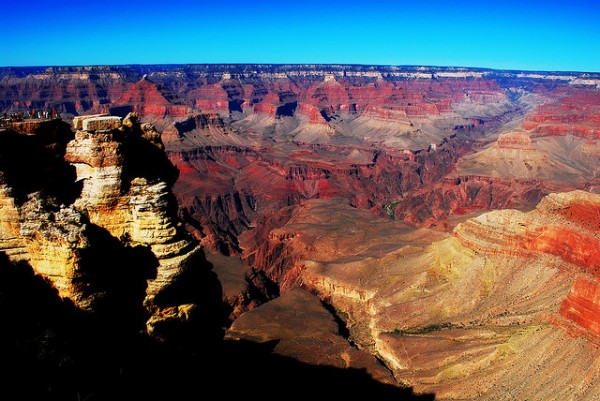
Arizona, with fewer than seven million residents, generates an outsized share of national headlines. Its rapid population growth, tough-on-crime politics, campaign finance laws, illegal immigration, and its distressed real estate market all have attracted notice. SB 1070, a controversial anti-illegal-immigration bill, made Arizona a leader in turning immigration enforcement into a local responsibility. Are the conflicts of Arizona politics characteristic of those facing the nation as a whole? Or is Arizona more of an outlier? In advance of “Is Arizona the Front Line of American Politics?“, a Zócalo event, several longtime observers of Arizona politics offer their answers.
It’s both microcosm and outlier

In the mid 2000s, Arizona was the epicenter of illegal immigration and suffered from the violence of the smuggling cartels. This included highway gun-battle hijackings of immigrant loads, confinement of immigrants in drop houses, and kidnappings. All Arizonans, not just conservatives, wanted something done about it, and conservative politicians who had been beating the anti-illegal immigration drum for years to no avail now had a constituency.
Candidates crusading against illegal immigration won handily in the 2008 and 2010 elections, devastating Democrats, gaining a two-thirds majority in both legislative houses and winning all state-wide elected offices, including that of governor.
Before Gov. Jan Brewer signed SB 1070, the state’s controversial anti-illegal immigration bill, she was stuck in the middle of candidate polls. After she signed it, she shot to the top of the polls and won the election with ease, despite having been silent during the debate of the bill, even refusing to say whether she’d sign it.
Clearly, Arizona is in the vanguard of the march of states to assert their rights to enforce immigration laws. But the politicians who benefitted from the anti-illegal immigration vote happened to be far-right, limited-government conservatives. Arizona’s voters are not nearly as conservative as the makeup of the state house and the legislation emanating from it would indicate. Republican registration in Arizona is barely 35 percent.
So our opposition to illegal immigration is probably normative, while our extremely conservative politics are probably an aberration and will revert back to their more moderate, right-of-center position over the next couple of election cycles.
Mark B. Evans is the editor/administrator of Tucsoncitizen.com.
————————————-
It’s a microcosm of our future demographics

If you visit the Hopi Indian pueblo of Orayvi on Third Mesa in northern Arizona, you stand in the oldest continuously occupied community in the United States. Hopis have been growing corn and praying for rain in Orayvi for nearly a thousand years, and they don’t plan on going away anytime soon.
About two hundred miles to the south, the emerging megalopolis of Greater Phoenix–the “Sun Corridor,” as it is described in the glossy pages of the futurists–sprawls across the desert in an endless agglutination of shopping centers and pseudo-Mediterranean subdivisions. In the Sun Corridor, people come and go, leaving behind a transient society with no sense of place or community. I grew up in Phoenix, and much of the built environment that defined my childhood is gone. Greater Phoenix is the endless future that obliterates the shallow past.
That dialectic–between the enduring and the transitory–shapes the ongoing contradiction that is Arizona. Surreal. Schizophrenic. Where the newcomers are xenophobic, forgetting that Arizona was once claimed by Spain and Mexico.
That makes Arizona the new microcosm of American politics. The great immigrant waves of the late 19th and early 20th centuries used to wash upon our shores at Boston or New York. Now they risk death from heat stroke to cross Arizona’s deserts. The Tucson sector is the busiest crossing monitored by the Border Patrol. Hundreds of migrants from Mexico and Central America die there each year, but hundreds of thousands more survive. The proportion of Hispanics in Arizona grew from 25 to 32 percent of Arizona’s population between 2000 and 2010. They are the fastest growing ethnic group in the state. Laws like S.B. 1070 are not going to reverse that demographic juggernaut. How Arizona responds to those immigrants will foretell the character of American politics and culture in the 21st century far better than anything that happens east of the Mississippi River.
Thomas Sheridan is professor of anthropology at the Southwest Center and School of Anthropology at the University of Arizona.
————————————-
If It’s a Microcosm, God Help Us

Arizona is certainly unique among the 50 states. It boasts 22 federally recognized Indian reservations, millions of acres of national forests, a complex water distribution system, and some of the country’s largest military bases. That leaves a substantial amount of Arizona, a much greater portion than most other states, out of reach of the state legislature for both regulations and revenue. Each year, Arizona’s majority party prefers to debate issues like denying birth certificates to certain newborn U.S. citizens and debating whether guns should be allowed in bars and even on college campuses instead of debating how to create jobs or economic growth. The local sheriff trades barbs with the county board over hundreds of millions of dollars of misused public funds and runs a jail notorious for tents and wrongful death lawsuits. Rare is the sheriff whose name is known outside his own county, but, then again, rare are the governor and legislators who balance a budget by denying healthcare to the most vulnerable citizens and decreasing an organ transplant waiting list through morbid attrition. All this transpires under the watchful eye of an increasingly despondent minority political party that includes among its leadership someone who once told me that going grassroots wasn’t really “what we’re looking to do.” On the other hand, our sports teams regularly make the playoffs, our landscapes are breathtaking, we have the grandest of canyons, and, hey, it’s a dry heat!
Still, just because Arizona is in some ways unique doesn’t mean that it’s an outlier overall.
In fact, investigative journalist Tom Barry of the Center for International Policy recently argued in the Boston Review that Arizona is more a microcosm than an outlier. But Arizona isn’t so much the embodiment of a larger nationwide movement as it is a leader in doing a few key things of interest to conservatives: cutting taxes, relaxing laws about firearms, and beefing up immigration enforcement. And even here, Arizona may be a follower. For all the attention given to SB1070, the controversial bill aimed at reducing illegal immigration, Prince William County in Virginia passed a similar bill in 2007.
Whether Arizona is really a microcosm of the U.S. depends on what view one takes on the direction the country as a whole. Are many other states looking to allow firearms on college campuses or increase their numbers of death row inmates? Perhaps, perhaps not. Certainly, some states are moving in that direction, but Illinois and New Mexico just abolished the death penalty, and other states are looking to reap similar long-term cost-savings through abolition. If one believes the U.S. will see more states maintain taxes at historically low rates, cut educational and healthcare programs across the board, ban high school ethnic studies programs, cut all-day kindergarten programs, privatize prisons, and sell off their state capitol buildings, then, yes, Arizona can be considered a microcosm.
I certainly hope not.
Nadine Arroyo Rodriguez is a reporter at KJZZ 91.5 FM.
————————————-
It’s a microcosm of the breakdown of our politics

While it would be easy to dismiss the craziness of Arizona politics as the product of a backwards, Old West mentality, it’s far more accurate to view it as a model of the new norm in American politics.
The complex issues we face today are less about an exchange of ideas and more about a duel of ideologies. Instead of working to try and understand the underlying issues, politicians are rewarded by simplifying them into black and white categories convenient for 30-second sound bites. Once the issue is presented through an us-versus-them prism, it becomes easier to reject all compromise.
The immigration debate in Arizona encapsulates this state of affairs. Take Maricopa County Sheriff Joe Arpaio, who makes news for misspending millions in taxpayer dollars, a failure to investigate more than 400 sex crimes, and a civil-rights investigation by the federal government. Arpaio enjoys sky-high voter approval. Why? Because, like his fellow former County Attorney Andrew Thomas, who’s facing disbarment, having a tough-on-illegal-immigration image matters more than ethical or lawful behavior.
The winners in this political climate are narrow-casted media and partisan politicians. The losers are the voters and those seeking civil discourse and solutions. Arizona is neither a follower nor an outlier but rather a leader in the breakdown of democracy.
Julie Erfle blogs at Politics UNCUFFED.
————————————-
Focus on the good ways it’s a microcosm

Nearly a century ago, Arizona’s first state governor, George W. Hunt, warned his fellow Arizonans that a national showdown was taking place in their state. “The working class, plus the professional class, represent 99 percent,” Hunt said. “The remaining 1 percent is represented by those who make a business of employing capital.” Made from a copper mining camp in rural Arizona, Hunt’s admonition still resonates on Wall Street today. As Hunt put it, “It will be a happy day for the nation when the corporations shall be excluded from political activity…and vast accumulations of capital cannot be employed in an attempt to control government.”
Long before Hunt and his labor shock troops ushered in one of the nation’s most progressive state constitutions in 1912, the clash over Arizona’s vast natural resources, its native and immigrant labor ranks, and its rooted inhabitants and carpet-bagging business interests had not only placed the state on the frontlines of American politics but also helped force our nation to come to grips with America’s fundamental commitment to civil rights and democracy.
Arizona has a long and terrible and beautiful history. But don’t dwell too much on SB 1070 and its fleeting Tea Party champions. It’s only the latest spasm of punitive and reactionary measures driven by economic failure and desperate politicians. Instead, dwell on the enduring legacy of true Arizonans and their contributions to the great American experience, from the centuries of sustainable living in Native communities, to the defiance of a single Mexican immigrant like Estevan Ochoa in the face of Confederate occupation, to the galvanizing uprising of Mexican and immigrant copper miners in Clifton-Morenci, to the role of World War II heroes like Sylvestre Herrera and subsequent campaigns for civil rights on the homefront, to inspiring Arizona native and labor champion Cesar Chavez and his “Si Se Puede” (Yes, We Can) campaign that not only reclaims Arizona’s place in the forefront of American politics, but drives the historic recall campaign of Tea Party President Russell Pearce today.
Raised in Tucson, author/journalist Jeff Biggers has a new book, State Out of the Union: Arizona and the Final Showdown Over the American Dream, forthcoming in spring, 2012.
*Photo courtesy of B Rosen.



